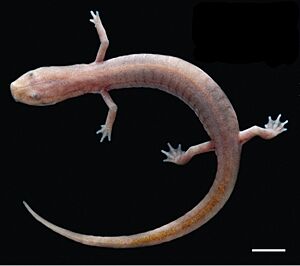Western grotto salamander facts for kids
Quick facts for kids Western grotto salamander |
|
|---|---|
 |
|
| Conservation status | |
| Scientific classification | |
| Synonyms | |
The western grotto salamander (Eurycea spelaea) is a special type of salamander. It is also known as the Ozark blind salamander. This animal lives only in the United States.
You can find it in places like freshwater springs, underground karst areas, and caves. Even though it is not currently in danger, its home can be affected. Changes in groundwater quality or a drop in bat populations can harm it.
Contents
How Scientists Study and Name Animals
The western grotto salamander was first found in 1891. This happened in the Ozark Plateau region. A scientist named Leonhard Hess Stejneger described it in 1892.
At first, it was called Typhlotriton speleus. Now, scientists consider it part of the Eurycea group of salamanders. For a while, scientists thought all grotto salamanders in the Ozarks were the same. But later, they found two other types. These are the northern grotto salamander and the southern grotto salamander.
A study in 2017 showed that these three types are actually different. They are like cousins that split apart a long time ago. Scientists believe all grotto salamanders came from an ancestor that lived above ground.
Where the Western Grotto Salamander Lives
This salamander lives in the karst areas of the Ozark Mountains. You can find it in parts of northwestern Arkansas, southeastern Kansas, southwestern Missouri, and northeastern Oklahoma.
When they are young, called larvae, they live in springs and streams. These places are usually near cave entrances. As they grow into adults, they move deep inside the caves. They spend the rest of their lives underground.
They like water that is cool, between 5.5 and 16.5 °C. They eat small animals that live in caves, like Gammarus. They also eat guano, which is bat droppings.
What the Western Grotto Salamander Looks Like
Young western grotto salamanders, or larvae, have bright colors. They can be brownish or purplish-gray. Sometimes they have yellow spots on their sides. Adults can grow up to 13.5 cm long. Larvae are usually between 10 and 30 mm.
They have a tall tail fin and gills on the outside of their bodies. Larvae that live in light, like in streams, have working eyes. But their eyesight might get weaker as they get older. If they grow up in darkness, their eyelids might close. Their eyes can also become less developed.
After two or three years, the larvae change. This change is called metamorphosis. During this time, they lose their gills. Their eyelids slowly close over the next year. Skin then covers their eyes, making them blind. The adult salamander then lives its life in a cave.
The adult salamander is pinkish-white. Sometimes it has hints of orange on its tail, feet, and sides. It also has 16 to 19 grooves on its sides. The western grotto salamander is special because it changes completely. Most cave salamanders do not go through such a big change.
This salamander eats many different things. It is an "opportunistic" eater. This means it eats whatever food it can find. Besides small water animals, it also eats bat guano. Bat guano is rich in nutrients. This helps the salamander find food in both water and on land inside the cave.
See also
- Cave salamander


